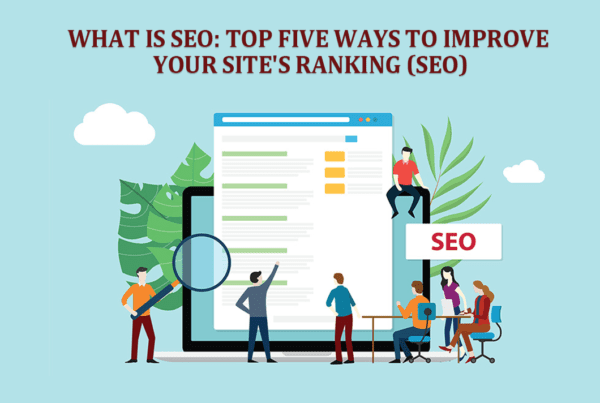What will SEO trends look like in 2021? Google is always updating, technology continues to evolve, and the market becomes more and more mature to keep up with changes. For that and more, the time has come to find out what your next optimization strategies should look like.
You already know the importance of having your content at the top of the Google ranking, don’t you?
Well-positioned pages generate a great organic reach to your website, increasing the possibility of attracting and converting leads. To achieve this goal, it is essential that you apply SEO techniques, which are designed to adapt your content to the positioning criteria of the Google algorithm.
In addition to the algorithm, it is also necessary to consider the behavior and preferences of the public. Ultimately, the most important factor to maintain a good positioning is the quality of the experience we offer to our website visitors.
Therefore, to achieve good results in a Digital Marketing strategy, it is essential that we are always aware of the possibilities of changes that arise with increasing frequency. With that in mind, we’ve selected the top 10 SEO trends for 2021:
- Relevant and valuable content
- EAT
- User experience (UX)
- Mobile SEO
- Core Web Vitals and on-page experience
- Search without clicking
- Site security
- Search intent
- More extensive content
- Local SEO
Study this list carefully and learn more about each of them!
1. Relevant and valuable content
If you don’t produce relevant and valuable content for your buyer persona, there is no point in following any SEO advice. This is a trend that will never change.
This is because all the factors analyzed by the Google algorithm are related in some way to the user experience. For your visitors to feel satisfied when visiting your website, they need to access rich and authentic content that offers them what they are looking for.
If this does not happen, the user presses the back button and chooses another of the several options present in the search results. This means that your brand will lose the opportunity to win a new client and, it can even generate a negative feeling towards your company.
To do this, focus on developing your strategy by taking advantage of the pains, needs, and desires of your buyer persona. Your goal should be to meet the demands of your visitors, not just Google bots.
At this point, it is worth considering the production of interactive content, which attracts and holds the attention of users more easily. In addition, interacting directly with the experience itself increases the chances that the visitor will feel satisfied and continue browsing your site.
2. EAT
Google’s understanding of a quality site that deserves to rank high in searches has changed over the years.
In the early days of the search engine, what mattered was the number of backlinks the page received and the keyword match.
Then it also started to count the quality of the content on the page. Later, he began to weigh the quality of the sites that linked to that page.
Today, Google makes clear what is essential to determine the quality of a page’s content. The search engine considers three important factors to assess whether pages deserve to appear well positioned in search results:
- Expertise (level of knowledge)
- Authoritativeness (authority)
- Trustworthiness (reliability)
These words constitute the EAT factors, which Google considers in the guidelines for search quality evaluators.
This document shows the algorithm guidelines for people manually evaluating the quality of search engine results.
These factors are not believed to be criteria for classifying the algorithm. However, they show what Google considers important to rank the pages. And, therefore, it deserves all your attention in SEO content and strategies.
But let’s be clear: EAT factors have been embraced by Google for years. However, it seems that the search engine is becoming more aware of these criteria when ranking sites.
And therefore, the acronym is increasingly used as a guide by SEO professionals.
Therefore, understand that your pages must have content created by those who understand the subject (level of knowledge), are benchmarks in the market (authority), and have the trust of the public (reliability).
This should be your approach so that Google understands the quality of your pages. But how to do this in practice? Here are some tips:
Be an expert in your field of action
Or, if you’re not, hire or partner with someone who is an expert on the subject.
Google wants to prioritize pages with specialized content so that it offers the most accurate, up-to-date, and reliable answer to what the user is looking for.
The websites of the area of health, for example, must be written by physicians or administered by institutions recognized in the field.
Be transparent about the authorship and ownership of the website
Google wants to know who was responsible for the content. So, have a full “about us” page, easy-to-find contact information, privacy policies, terms of service, and author signature on blog articles.
3. User experience (UX)
As we saw in the previous topic, user satisfaction is still extremely relevant to the success of an SEO strategy. However, it is important to note that this satisfaction does not depend only on qualified and relevant content. It is necessary to offer a complete experience.
So investing in user experience (UX) techniques is one of the top SEO trends for 2021. But what does that mean?
When applied to Digital Marketing, UX relates to user interaction with brand channels. It must happen in a simple, accessible, and barrier-free way.
In other words, when accessing your website, your visitors must find fast-loading pages, intuitive menus, and other elements that make the experience richer and more efficient.
From now on, Google’s algorithm will also take all of this into account. The information comes from a post on the Google Webmaster Central Blog, which explains how the algorithm evaluates the experience on the page to define your position in the ranking.
Therefore, if you want to maximize your SEO results in 2021, you will need fast, stable and interactive pages. To track the current performance of your pages, it’s worth taking a look at Google PageSpeed Insights.
4. SEO for mobile
If you’ve been following the SEO trends of the past few years, you’ve undoubtedly noticed that mobile SEO was among them and it wasn’t a coincidence. Since 2019, Google has been analyzing mobile website pages as major versions, leaving PC versions as minor.
Therefore, mobile SEO is the key to the success of your strategy and becomes even more relevant in 2021. This is because the number of people accessing the Internet from smartphones continues to grow.
5. Core Web Vitals and on-page experience
In addition to efforts to optimize the digital experience for users, Google launched Core Web Vitals in 2020.
- Large Contentful Paint (LCP)
- Cumulative Layout Shift (CLS)
We will talk about each one of them!
Large Contentful Paint
The LCP measures exactly how long a page takes to load and display its main content? Therefore, it refers to the load factor of Core Web Vitals. The ideal, according to Google, is to keep the LCP at 2.5 seconds maximum.
Cumulative Layout Shift
Finally, we have the CLS, which refers to the volume of unexpected design changes in visual content.
6. Search without clicking
From time to time, Google makes changes to the design and layout of search results pages to provide faster and more effective consumer experiences. Recently, the platform began to focus on click less searches, that is, results that appear at the top of the first page.
Now, zero-click is more present than ever: more than 50% of searches on Google end without the user clicking on anything. This content directly answers the questions asked by users in the search bar.
7. Site security
It’s not new for Google to consider the safety status of your site when analyzing its relevance and, of course, assigning it a position. Therefore, if you want your SEO strategy to be successful, it is important to add security features to it, such as specialized plugins and SSL certificates.
In 2021, with an audience increasingly aware of the threats present in insecure environments on the Internet, the trend is that the protection of websites becomes even more important.
After all, if people don’t feel safe accessing your pages, your access rate will drop dramatically, as will your ranking on Google.
8. Search intent
User-centric optimization has been a top Google priority for a long time. The goal is always to deliver content that meets the audience’s expectations.
To do this, Google released Bidirectional Encoder Representations from Transformers, the BERT algorithm. This technology seeks to optimize the understanding of what the search terms represent in a given context.
In other words, the algorithm allows Google to interpret the intent of a specific search, even if it includes language with more colloquial terms. Therefore, it becomes even more important to produce content that directly corresponds to the intentions of users, always using natural language.
With the introduction of the BERT algorithm, Google is improving its effectiveness in delivering more appropriate content to its users, increasing the demand for quality.
9. More extensive contents
As we showed before, experience, authority, and trust are the elements that are becoming increasingly relevant in the world of Content Marketing.
The idea is to guarantee users that the content they are consuming is really of quality and, for this, a deeper investigation is usually necessary and the result is more complete content.
Therefore, one of the most important things to do is invest in the production of more complete and, consequently, extensive content. The State of Content Report provides data confirming the relevance of longer materials.
According to the study, texts of more than 3,000 words get 3 times more traffic, 3.5 times more backlinks, and are 4 times more shared than the average number of articles (901-1,200 words). This contributes to increasing the organic reach of your brand and developing your digital authority, which results in better positions in Google.
10. Local SEO
The Covid-19 pandemic was the great event of 2020. In addition to the consequences of social distancing on health and public accounts, consumers also changed their habits and began to appreciate local commerce better.
This was due to several factors. First, the economic crisis motivated the population to focus on supporting the local market to keep the economy running. At the same time, transportation constraints led more people to seek out establishments close to their homes.
Conclusion
Being in the local SEO ranking means establishing a positive link with the neighborhood and also attracting customers who are passing through the city. Understanding SEO trends and adapting to them is essential to improve the results of our digital strategy in 2021.










canadian pharmacies-24h http://pharmacylo.com/ canadian drugs online pharmacies
Antabuse https://pharmacylo.com/ go coupon